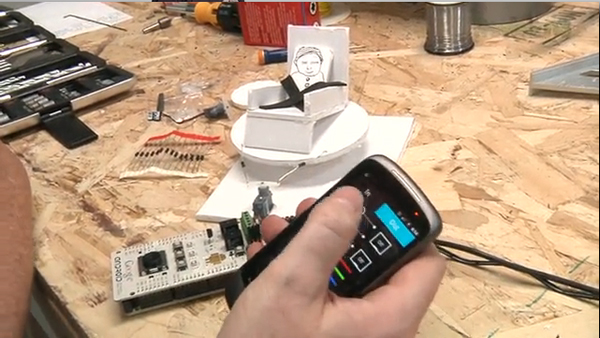BUILD YOUR OWN UNDERSEA ROBOT
– September 1st, 2011
David Schneider from [IEEEspectrum] tells and shares his DIY Remotely Operated Vehicle undersea, based on two Arduinos
Last year at about this time, crews in the Gulf of Mexico were working feverishly to bring BP’s blown-out oil well under control. Some of the more spectacular parts of that effort, as you may recall, involved the use of remotely operated vehicles, or ROVs. Perhaps you had the same thought as I did—that it would be cool to build one.
And shares all the instructions to build your own [.zip].
via [IEEESpectrum]
DISPLAYING ON PAPER – THERMAL PRINTER + ARDUINO
– August 31st, 2011

Guys at [bildr] wrote a nice tutorial on how to control & use a thermal printer with Arduino.
Outputting data can be extremely useful, and typically when we look at doing this, it is either to the Arduino’s serial terminal, or to some sort of display. But what about making physical copies of the data? (…) If you dont know about thermal printers, they are most often the printers your store’s receipts are printed on. The reason for this is that they dont use ink, or use a cartridge of any sort. The paper it prints on turns black when heated. So this printer simply applies heat where another printer would apply ink.
via [bildr]
ARDUINO TREE-CLIMBING ROBOT AS THE FIRST CHALLENGE
– August 30th, 2011
[Tecnochicken] has challeneged his arduino and robotic skills in developing a tree-climbing robot based on a L298 H-Bridge Motor Driver and some design time in Sketchup.
After I got comfortable programming and building with an Arduino, I decided to build a robot. I did not have any particular type in mind, so I wracked my brain (and the internet) for cool robot ideas. Eventually, somehow the idea popped into my head to build a robot that could climb trees. At first I dismissed the idea as beyond my skill level, but after further thought, and some time in Sketchup, I decided to take a shot at the challenge.
Fully explained on [Instructables]
SERENADING WITH ARDUINO
– August 30th, 2011
WHEN MUSIC MEETS ARDUINO
– August 29th, 2011
A beautiful project by [Leigh Davis]. It is a brilliant proof of how Arduino fits into virtually any sphere of thought and is the shortest path for a creator realizing his idea in reality.
He writes:
I began the first few days by developing a stand alone application build inMaxMSP that understands the notes that a play on my (recently purchased second-hand) flute. I set the range from low C right up to the 3rd octave D. Each note of the chromatic scale triggers a bang, which is coloured uniquely to the other notes bang messages.
The bang message then sets the corresponding color to the display screen on the application. Which will in turn send a signal to the arduino to dispense the corresponding oil color on water according to the different notes. (Something like a physical Milkdrop!)He further plans to control different LEDs, motors and the likes using the Rayne application.

ARDUINO DASHBOARD APP
– August 26th, 2011

[Jonathan Clark] from Lousiville Hackerspace has developed an application that is constantly checking the state of I/O pin of your Arduino board, updating a window on your desktop.
ArduinoDashboard is an application for viewing analog and digital pin sensor values from an arduino in real time. This can be used with any arduino sketch and now has compiled versions with no need to download processing.org ide. Sources included as well.
INTRODUCING PRIYA
– August 26th, 2011

I’m happy to announce that the Arduino family is now bigger: Priya Kuber (twitter, site) is going to help us out on our blogging queue as well as managing several internal projects. She is living in New Dehli, and has fallen in love for electronics & tinkering at the age of 12 in her fathers’ workshop at home. She is also the co-founder of 9circuits, one of our indian distributor.
Young, yet well experienced, she is familiar with coding and in dealing with online communities.
Above all, I am challenged to share the Arduino Blog with a woman (in a man-oriented world like electronics is) from India (one of the most relevant coutries in terms of electronics and components supply).
Stay tuned for new, upcoming surprises!
ANDROID DEV KIT ON THE BEN HECK SHOW
– August 23rd, 2011
The Ben Heck Show, the DIY format on Revision3, explains and uses the Android Development Kit.
On this weeks The Ben Heck Show, Ben jumps right in to using the Android Accessory Development Kit and gets started on building a Baby Rocker that simulates vehicle motion from logged Android sensor data.
It’s amazing to see different efforts in building detailed instructions in using the board and the way this Arduino-to-Android device is changing the design for apps and physical interfaces. For more info check our ADK LABs page.
THE TACIT PROJECT LETS YOUR WRIST GUIDE YOU
– August 22nd, 2011

[Steve Hoefer] shared an interesting solution for visually impaired people.
It measures the distance to things and translates that into pressure on the wrist.[...] It’s wrist mounted and senses objects from about 1 inch (2 cm) to 10 feet (3.5m). It has generally fast response time (fractions of a second) to quickly navigate complex environments.
It’s not the first time we see Arduino used for custom solutions to navigate a room and / or enviroment, replacing the sight (above all, you’ll remember the [Bat Googles] project from USI and [Halo], the winner project of Humana competition).
“Tacit”, that’s how’s called this cool project, is the first in moving the sensitive response area of the device from the head (closed to the ears) to wrists (closed to the hands). Steve, whom its first prototype was conceived has an headband like the two projects above, moved its device to the wrist for several reasons
The headband was a great first test, and it did work, but it had two fatal flaws:1) The most dangerous obstacles are not at head level. Furniture and most of the other things that can be tripped over and stubbed on are waist level or lower.2) Vibrating motors stuck on your skull will drive you insane quickly.In addition it would be a challenge to disguise it as anything but some mad-science-looking headband, and blind people do care how they look.
Tacit is wonderfully referenced and it’s realeased in CC-NC-SA
via [Grathio Labs]
THE LAUNDRUINO LETS YOU KNOW WHEN YOUR CLOTHES ARE DONE OVER THE NET
– August 18th, 2011

[Micha] has a washing machine with an inaccurate time data displayed on the front panel. How to solve this?
Since it is located in his basement, he hated having to check on the machine continually to know when his clothes were done. Instead of hauling up and down the stairs over and over, he decided to hack in an “end of cycle” notifierof his own.The washer has an LED that lights when it is finally done doing its thing, so [Micha] removed the LED and soldered in two wires, which he then connected to his Arduino. When the washer is finished and the LED should be lit, the Arduino senses that the input has been pulled low, signaling the end of the cycle. The Arduino was hooked into his home network via an Ethernet shield, enabling him to monitor the process from the comfort of the nearest web browser.










0 comentarios:
Publicar un comentario